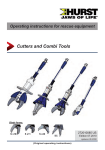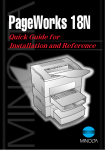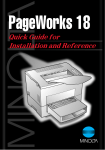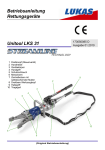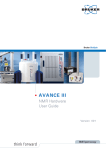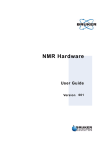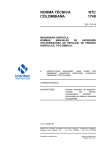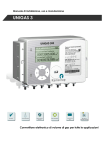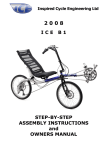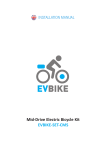Download Operating instructions for rescue equipment Unitool
Transcript
Operating instructions for rescue equipment 173050085 GB Edition 01.2010 Unitool LKS 31 replaces 12.2008 1 2 3 4 5 6 7 Rotary knob (control valve) Hand lever Tool body Handle Protection hose Blade arm Pivot bolt with self-locking nut 8 Rotating tool head 9 Handle 10 Carrying belt 9 2 3 5 4 7 10 6 8 1 (Translation of the original operating instructions) 2 Contents Page 1. Hazard classes 4 2. Product safety 5 3. Proper use 8 4. Description of the functions 9 4.1 Description 9 4.2 Control of working movements 9 5. Operation 10 5.1 Control of working direction 10 5.2 Movement of the blade arms 10 6. Cutting, spreading, pulling and squeezing 11 6.1 Safety instructions 6.2 Cutting 11 6.3 Spreading 12 6.4 Pulling 13 6.5 Squashing 13 11 7. Dismantling the equipment / deactivation following operation 14 8. Maintenance and service 14 9. Repairs 15 9.1 General points 15 9.2 Preventative service 16 9.3 Repairs 16 10. Troubleshooting 19 11. Technical Data 20 20 11.1 Combi tools 11.2 Tightening torques for pivot bolt 20 11.3 Cutting performance 21 11.4 Operating and storage temperature ranges 21 12. EC Declarations of conformity 22 13. Notes 23 3 1. Hazard classes We distinguish between various categories of safety notes. The table below gives you an overview of the assignment of symbols (pictograms) and key words to the specific hazard and possible consequences. Pictogram Damage / injury to Key word Definition Death or major injury WARNING! Potentially dangerous situation Potential death or major injury CAUTION! Less dangerous situation Minor or slight injury device human DANGER! Immediate danger Consequences Danger of CAUTION! damage to device / environment Damage to the equipment, damage to the environment, damage to surrounding materials - Advice for application and REMARK other important / useful information and advice No injury / damage to persons / environment / equipment Wear helmet with face protection Wear safety gloves Wear safety shoes Proper recycling Observe principles of environmental protection Read and observe operating instructions 4 2. Product safety LUKAS products are developed and manufactured in order to guarantee the best performance and quality when used properly. Operator safety is the most important aspect of the product design. Moreover, the operating instructions are intended to help the safe use of LUKAS products. The generally applicable, legal and other binding regulations pertaining to the prevention of accidents and protection of the environment apply and are to be implemented in addition to the operating instructions. The equipment may only be operated by persons with appropriate training in the safety aspects of such equipment – otherwise, there is a danger of injury occurring. We would like to point out to all users that they should read carefully the operating instructions and the instructions contained therein before they use the equipment, and that they should carefully follow such. We further recommend that a qualified trainer train you in the use of the product. WARNING / CAUTION! The operating instructions for the hoses, the accessories and the connected hydraulic equipment must also be observed! Even if you have already received instructions on how to use the equipment, you should still read the following safety notes through again. WARNING / CAUTION! Ensure that the accessories and connected equipment used are suitable for the max. operating pressure! Please ensure that no body parts or clothing get stuck between the visibly moving parts (e.g. blade arms). It is prohibited to work under load if this load is lifted exclusively by hydraulic equipment. If this work is absolutely imperative, additional mechanical supports must be used. Wear protective clothing, safety helmet with visor, protective gloves Inspect the equipment before and after use for visible defects or damage The responsible department is to be informed immediately of any changes (including to the operating behaviour)! If necessary, the equipment is to be deactivated immediately and secured! Inspect all cables, hoses and screwed connections for leaks and externally visible damage! If necessary, repair immediately! Squirting hydraulic fluid can result in injuries and fires. 5 In the event of malfunctions, immediately deactivate the equipment and secure it. The malfunction is to be repaired immediately. Do not carry out any changes (additions or conversions) to the equipment without obtaining the prior approval of LUKAS. Observe all safety and danger notes on the equipment and in the operating instructions. All safety and danger notes on the equipment are to be kept complete in a legible condition. Any mode of operation which impairs safety and/or stability of the equipment is forbidden! Comply with all specified dates or dates specified in the operating instructions pertaining to regular controls / inspections on the equipment. Safety devices may never be deactivated! The maximum permitted operating pressure noted on the equipment must not be exceeded. Before the equipment is switched on/started up, and during its operation, it must be ensured that nobody is endangered by the operation of the equipment. Only original LUKAS accessories and spare parts may be used for repairs. When working close to live components and cables, suitable measures must be taken to avoid current transfers or high-voltage transfers to the equipment. Please note that, when cuttung or spreading, tearing or breaking can cause falling material, or sudden removal of such can cause it to suddenly catapult off: necessary precautions need to be taken. The build-up of static charge with the potential consequence of spark formation is to be avoided when handling the equipment. Only touch any broken-off parts or the cut-off parts wearing protective gloves, since the torn / cut edges can be very sharp. 6 The equipment is filled with a hydraulic fluid. These hydraulic fluids can be dangerous to health if swallowed or their vapours inhaled. Direct contact with the skin is to be avoided for the same reason. Please also note that hydraulic liquids can also have a negative effect on biological systems. When working with or storing the equipment, ensure that the function and the safety of the equipment are not impaired by the effects of stark external temperatures or that the equipment is damaged in any way. Please note that the equipment can also heat up over a long period of use. Ensure adequate lighting when you are working. Before transporting the equipment, always ensure that the accessories are positioned such that they cannot cause an accident. Always keep these operating instructions within reach where the equipment is used. Ensure the proper disposal of all removed parts, left-over oil and hydraulic fluid as well as packaging materials! The generally applicable, legal and other binding national and international regulations pertaining to the prevention of accidents and protection of the environment apply and are to be implemented in addition to the operating instructions. WA R N IN G / C A U T I O N! The equipment is to be used exclusively for the purpose stated in the operating instructions (see chapter “Proper Use”). Any other or further use is not considered proper use. The manufacturer / supplier is not liable for any damages resulting from improper use. The user bears sole responsibility for such. Observance of the operating instructions and compliance with the inspection and maintenance conditions are part of the proper use. Never work when you are overtired or intoxicated! 7 3. Proper use LUKAS handheld combi tools are specially designed for the rescue of casualties in road accidents, rail accidents and in air travel, and for rescue from buildings. They serve the purpose of freeing injured people in accidents e. g. by cutting doors, roof bars and hinges. Trapped persons can also be freed using them e. g. by forcing open doors and/or by removing obstacles with the aid of a chainset. LUKAS handheld combi tools can basically be used to cut, pull, open, squeeze and lift objects. All objects which are to be worked on are to be secured using stable supports or substructures. LUKAS handheld combi tools are also suitable for use underwater down to a depth of 40 m (131 ft). CAUTION! In this case, you must strictly observe any leaks in order to avoid threats to the environment. WARNING / CAUTION! All objects which are to be worked on are to be secured using stable supports or substructures. WARNING / CAUTION! The following may not be cut / squeezed: - live cables - pretensioned and hardened parts such as springs, spring steels, steering columns and rollers - tubes / hoses under gas or liquid pressure, - compound materials (steel/concrete) - explosive bodies such as airbag cartouches NEVER operate the rescue equipment at a higher operating pressure than that stated in the chapter “Technical data”. A higher setting can result in material damage and/or injuries. Spare parts and accessories for the rescue tool can be ordered from your authorised LUKASdealer! 8 4. Description of the functions 4.1 Description The LUKAS handheld combi tools are a combi tool and handpump rolled into one unit. Hydraulic power packs and energy supply or accumulators are therefore not required to generate the required hydraulic pressure. This is generated by moving the attached handle, in exactly the same manner as a hand pump. The working section of the tool is configured so that two equal opposing blade arms with mechanical joints open or close symmetrically in order to open, squeeze, pull or cut objects. In addition, LUKAS handheld combi tools are fitted with a tool head that can rotate through 360° to allow optimum application of the blade arms at all times and ensure optimum pumping. 4.2 Control of working movements The working direction is adjusted before actuating the hand lever by turning the rotary knob to the desired switching end point (see cover sheet Item 1). The hand lever is actuated to move the two blade arms in the specified working direction. 9 5. Operation 5.1 Control of working direction The working direction is adjusted before actuating the hand lever by turning the rotary knob to the desired switching end point. Turn to the right = Turn to the left = Blade arms close Blade arms open - Cutting - Spreading 5.2 Movement of the blade arms Actuate the hand lever (up and down movement) to move the two blade arms in the set working direction. REMARK: We recommend that you always use full strokes when pumping, in other words the hand lever must always be moved from one end stop to the other end stop. 10 6. Cutting, spreading, pulling and squeezing 6.1 Safety instructions Before rescue works can commence, the position of the obstacle must be stabilised. You must ensure an adequate substructure and / or adequate support of the object. World-wide, safety guidelines pertaining to the specific country are to be observed and complied with. In the Federal Republic of Germany, regular safety inspections according to the GUV legal accident insurance regulations (Gesetzlichen Unfallversicherung) are mandatory. In the event of a potentially explosive situation, it is not permitted to use motor pumps (danger of the formation of sparks). In such cases, hand pumps are to be used. The following are to be worn when working with the rescue equipment: - protective clothing, - safety helmet with visor or protective goggles, - protective gloves - and, if necessary, ear protection Before activating the rescue equipment, always ensure that there is no danger to persons either involved / uninvolved in the action by the movement of the rescue equipment or by flying fragments. Further avoid unnecessary damage to property belonging to others, objects not involved by the rescue equipment / flying fragments. Reaching between the blade arms is strictly forbidden! WARNING / CAUTION! The particular effect of the force of the rescue equipment during operation could cause pieces of the vehicle to break off or fly off, posing a danger to persons. Those not involved in the rescue operation should therefore keep at a distance appropriate to the situation. 6.2 Cutting The blades must be positioned at a 90° angle to the object to be cut. 90° FALSE RIGHT Higher cutting capacities can be achieved by cutting as close as possible to the blade’s pivot point. FALSE RIGHT 11 During cutting, the gap between the blade tips (in the crosswise direction) of 3 mm (0.12 inches) must not be exceeded, otherwise the blade may break: CAUTION! Avoid cutting particularly high-strength parts of the vehicle’s bodywork (e.g. side-impact protection): this almost always damages the combi tool! 6.3 Spreading Use the front area of the tips for increasing the gap only. Full spreading capacity can be achieved when approximately half of the grooved area of the tips is used. The greatest force is created in the rear area of the spreading range of the combi blade. Working surface is too small, tips slip off. Only for increasing the size of a gap (not suitable for spreading) Tips get a safe grip. 12 Work with the tips only. Do not damage the arms. 6.4 Pulling You may only use LUKAS chain sets for pulling purposes. Before the pulling process can be performed, ensure that the bolt and hook fit correctly to prevent the chain from slipping. Only chain sets in perfect condition may be used! The pull chains are to be inspected at least once per year by an expert! See separate operating instructions for the relevant LUKAS chain set in order to correctly attach, affix and use the chain sets. A The connection pieces of the LUKAS chain sets are affixed to the boreholes A on the blades using load bolts (see figure, right). appropriate chainset: KSV 7 6.5 Squashing Basically, squeezing can only be carried out in the area of the tips (see figure below). Squeezing area 13 7. Dismantling the equipment / deactivation following operation Once work has been completed, the blade arms are to be closed so that there is a tip distance of just a few mm. This relieves the hydraulic and mechanical strain on the equipment. REMARK: Never store the combi tool with the blade arms fully closed! The complete closure of the blade arms can cause hydraulic and mechanical stress to build up again. Free the rescue equipment of any stubborn dirt which may have become attached during use. If the equipment is to be stored for a longer period of time, the exterior is to be cleaned completely and the mechanically mobile parts are to be lubricated. Avoid storing the rescue equipment in a damp environment. 8. Maintenance and service The equipment are subject to very high mechanical stresses. A visual inspection is to be carried out after every use: however, at least one visual inspection is to be carried out every six months. These inspections enable the early detection of wear and tear, which means that punctual replacement of this wearing parts prevents breakages from occurring. Also regularly check the torque of the pivot bolt. (Torque MA see “Technical Data”) Every three years also a crack test of the blades are essential. Therefore a special crack testing kit is available. Every three years or if there is any doubt regarding the safety or reliability of the equipment, a function test must also be performed. (Please also observe the relevant valid national and international regulations pertaining to service intervals of rescue equipment). In the Federal Republic of Germany, regular safety inspections according to the GUV legal accident insurance regulations (Gesetzlichen Unfallversicherung) are mandatory. CAUTION! Clean off any dirt before controlling the equipment! WARNING / CAUTION! In order to carry out maintenance and repair works, tools appropriate for the job and personal protecting equipment are essential. 14 Inspections to be carried out: Visual inspection • Opening width of the blade arms on the tips (see chapter “Technical data”), • General tightness (leaks), • Ease of movement of the hand lever, • Ease of movement of the rotary knob, • Existence and stability of handle, • Ease of rotational movement of tool head through 360°, • Labels completely existent and legibly, • Covers in perfect condition, • Torque control of the pivot bolt (torque MA see "Technical data"), • Blade arms free of tears and without any chipped spots or deformations on the cutting surfaces, • Cutting surfaces go on top of each other without making contact, • Bolts and retaining rings of the blade arms must be present and in correct working order, • Grooving of the tips must be clean and squared, and not have any tears (applies to combi tools) Function test • problem-free opening and closing when operating the hand lever and adjusting the rotary knob, • no suspicious noises. • blade arms stop moving when the movement of the pump is interrupted during the process (dead man’s handle) 9.1 General points 9. Repairs Servicing may only be carried out by the manufacturer or personnel trained by the manufacturer and by authorised LUKAS dealers. Only LUKAS spare parts may be used to replace all components (see spare parts list) since special tools, assembly advice, safety aspects, inspections might have to complied with (see also chapter “Maintenance and Service”). During assembly, ensure the complete cleanliness of all components, since dirt can damage the rescue equipment! WARNING / CAUTION! Protective clothes must be worn when repairs are being carried out, since parts of the units can also be pressurised in an idle state. REMARK: Please always return the guarantee registration card to LUKAS Hydraulik GmbH. Only then are you entitled to the extended guarantee. CAUTION! Because LUKAS rescue equipments are appropriate for highest achievements, only components may be exchanged, which are specified in the spare parts list of the appropriate equipment. Further components of the equipment may only be exchanged, when: - you have participated on a appropriate LUKAS service training. - you have the express permission of LUKAS customer service (after inquiry, assessment prior to granting of permission. All cases must be assessed individually!) 15 9.2 Preventative service 9.2.1Note concerning care The exterior of the equipment is to be cleaned from time to time in order to protect it from external corrosion. Oil is to be applied to the metallic surfaces. 9.2.2 Functional and loading test If there is any doubt regarding the safety or reliability of the equipment, a function and load test must also be performed. LUKAS offers appropriate test equipment to this end. 9.3 Repairs 9.3.1Replacing the blades, protection hose and handle 1. First of all, carefully clean the rescue equipment. 2. Next, close the blade arms so that the tips are almost touching. REMARK: The blade bolts are only accessible when the blade arms are almost touching. 3. Remove self-locking nut (A) and push the pivot bolt (B) out. D A C B 4. Slide the protection hose slightly to one side until the locking bolts (C) are easily accessible. 5. Remove the retaining rings (D) and push out bolt (C). C E D 6. Now, you can remove blade (E) and sliding plates (F). F 16 E 7. Fold in the lever elements (G). G 8. Finally, remove the protection hose (H) from the tool as shown. H 9. Unfasten the screws (J) and remove them. J 10. Slide the handle (K) towards the lever elements to remove it and also remove the washers (L) underneath. K L 11. Assembly is carried out in the reverse order. REMARK: If you only want to change the blade arms, carry out the work up to step 6 and step 11. If you want to change the protection hose, carry out the work up to step 8 and step 11. CAUTION! Don’t forget to apply LUKAS special grease to all sliding surfaces. 17 CAUTION! The nut of the pivot bolt and the pivot bolt itself will be adapt together by a special procedure, therefore they have only be changed as a set by usage of a new set! Because of the special procedure an unscrewing of the nut while working will be minimized and a resulting blade crack will be prevented. The nuts can be unscrewed and thigtend up to 10 times without affecting the service performance! 9.3.2 Labels All damaged and/or illegible labels (safety notices, type plate, etc.) must be renewed. Procedure: 1. Remove damaged and/or illegible labels. 2. Clean the surfaces using acetone or industrial alcohol. 3. Attach new labels. Ensure that you attach the labels in the right position. If you are no longer sure about this, then please contact your authorised LUKAS dealer or LUKAS itself. 18 10. Troubleshooting Trouble The blade arms cannot be fully opened or closed Tool does not deliver the specified power Control Hydraulic fluid leaks on the piston rod Material to be cut slides between the blade arms during cutting Cause Insufficient hydraulic fluid in the tool Tool defective Solution Repair by an authorised dealer, by personnel specially trained by LUKAS, or by LUKAS itself Defective rod seal Damage to the piston Check pivot bolt Tool head cannot be turned Pivot bolt not tightened with the prescribed torque Tighten the pivot bolt. Tool under pressure Dump the pressure in the tool If it isn’t possible to rectify the malfunctions, inform an authorised LUKAS dealer or the LUKAS customer service department immediately! The address for the LUKAS customer service department is: LUKAS Hydraulik GmbH Weinstraße 39, Postfach 2560, D-91058 Erlangen D-91013 Erlangen Tel.: (+49) 09131 / 698 - 348 Fax.: (+49) 09131 / 698 - 353 19 11. Technical Data Since all values are subject to tolerances, minor differences may occur between the data on your equipment and the data in the following schedules! 11.1 Combi tools type LKS 31 ref.no. 173050000 [mm] Dimensions (l x w x h) [in.] 833 x 170 x 150 32.80 x 6.69 x 5.91 [mm] 182 [in.] 7.17 max. cutting force (rear end of the cutting surface) [kN] 204 [lbf.] 45,863 max. spreading distance (on the blade tips) [mm] 256 [in.] 10.08 max. spreading force (25mm from the tips) [kN] 25 [lbf.] 5,621 [kg] 10,9 [lbs.] 24.0 max. cutting opening weight incl. hydraulic fluid 11.2 Tightening torques for pivot bolt type LKS 31 pivot bolt wrench size torque M24 x 1,5 [mm] 36 [in.] 1.42 [Nm] 100 +10 [lbf.in.] 885 + 89 20 11.3 Cutting performance Cutting material Cutting material dimensions LKS 31 Round material steel (acc. to EN 13204) Round material steel (acc. to NFPA 1936) max. [mm] [in.] 22 0.87 22 0.87 11.4 Operating and storage temperature ranges Operating temperature [°C] -20 … +55 Ambient temperature (device in operation) [°C] -25 … +45 Storage temperature (device not in operation) [°C] -30 … +60 Operating temperature [°F] -4 … +131 Ambient temperature (device in operation) [°F] -13 … +113 Storage temperature (device not in operation) [°F] -22 … +140 21 12. EC Declarations of conformity 22 13. Notes 23 Please dispose all packaging materials and dismantled parts properly LUKAS Hydraulik GmbH Tel.: (+49) 0 91 31 / 698 - 0 Fax.: (+49) 0 91 31 / 698 - 394 e-mail: [email protected] Made in GERMANY Unitool_BA_GB_173050085_0110.indd © Copyright 2010 LUKAS Hydraulik GmbH subject to revision Weinstraße 39, D-91058 Erlangen Postfach 2560, D-91013 Erlangen
























